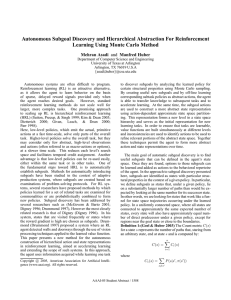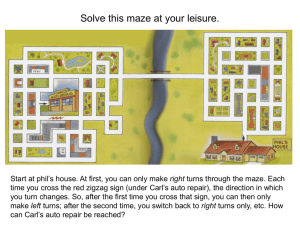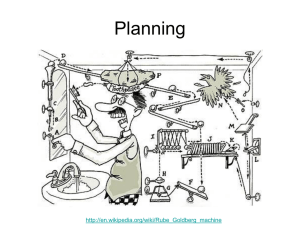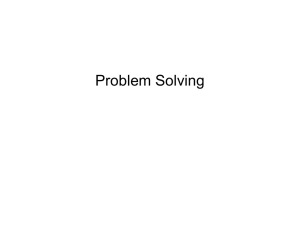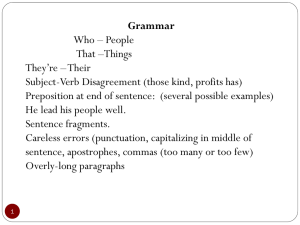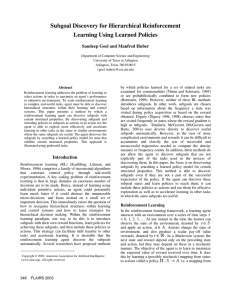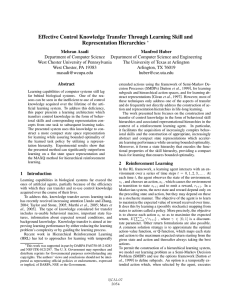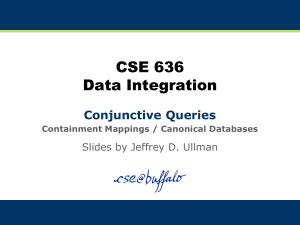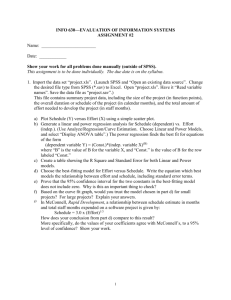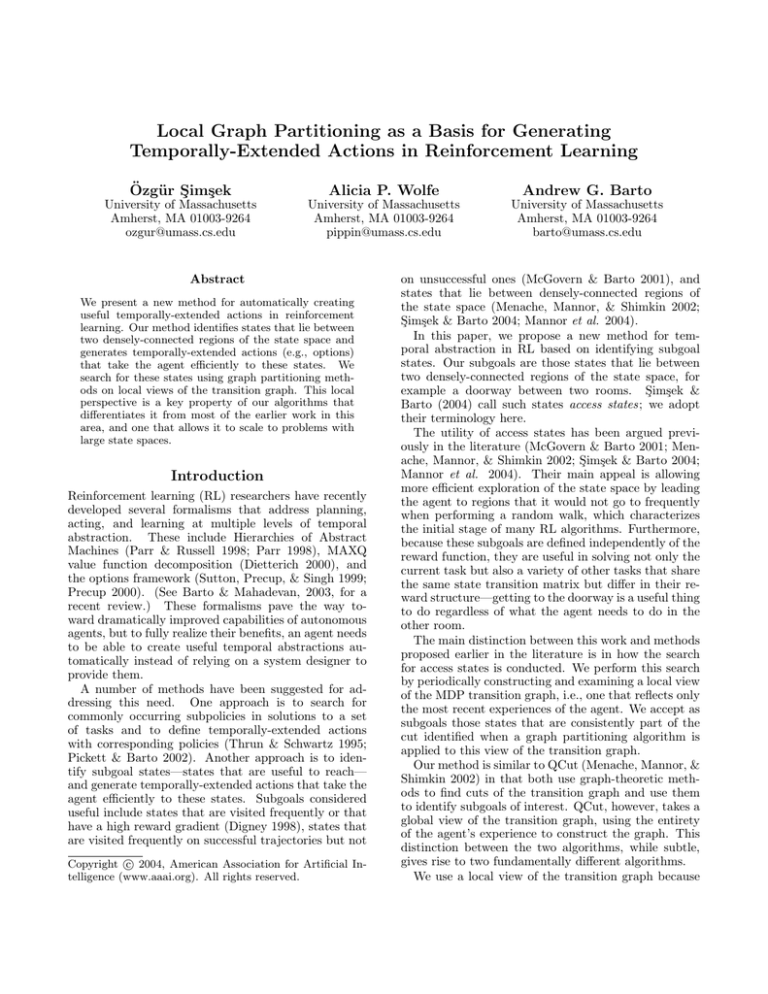
Local Graph Partitioning as a Basis for Generating
Temporally-Extended Actions in Reinforcement Learning
Özgür Şimşek
Alicia P. Wolfe
Andrew G. Barto
University of Massachusetts
Amherst, MA 01003-9264
ozgur@umass.cs.edu
University of Massachusetts
Amherst, MA 01003-9264
pippin@umass.cs.edu
University of Massachusetts
Amherst, MA 01003-9264
barto@umass.cs.edu
Abstract
We present a new method for automatically creating
useful temporally-extended actions in reinforcement
learning. Our method identifies states that lie between
two densely-connected regions of the state space and
generates temporally-extended actions (e.g., options)
that take the agent efficiently to these states. We
search for these states using graph partitioning methods on local views of the transition graph. This local
perspective is a key property of our algorithms that
differentiates it from most of the earlier work in this
area, and one that allows it to scale to problems with
large state spaces.
Introduction
Reinforcement learning (RL) researchers have recently
developed several formalisms that address planning,
acting, and learning at multiple levels of temporal
abstraction. These include Hierarchies of Abstract
Machines (Parr & Russell 1998; Parr 1998), MAXQ
value function decomposition (Dietterich 2000), and
the options framework (Sutton, Precup, & Singh 1999;
Precup 2000). (See Barto & Mahadevan, 2003, for a
recent review.) These formalisms pave the way toward dramatically improved capabilities of autonomous
agents, but to fully realize their benefits, an agent needs
to be able to create useful temporal abstractions automatically instead of relying on a system designer to
provide them.
A number of methods have been suggested for addressing this need. One approach is to search for
commonly occurring subpolicies in solutions to a set
of tasks and to define temporally-extended actions
with corresponding policies (Thrun & Schwartz 1995;
Pickett & Barto 2002). Another approach is to identify subgoal states—states that are useful to reach—
and generate temporally-extended actions that take the
agent efficiently to these states. Subgoals considered
useful include states that are visited frequently or that
have a high reward gradient (Digney 1998), states that
are visited frequently on successful trajectories but not
c 2004, American Association for Artificial InCopyright telligence (www.aaai.org). All rights reserved.
on unsuccessful ones (McGovern & Barto 2001), and
states that lie between densely-connected regions of
the state space (Menache, Mannor, & Shimkin 2002;
Şimşek & Barto 2004; Mannor et al. 2004).
In this paper, we propose a new method for temporal abstraction in RL based on identifying subgoal
states. Our subgoals are those states that lie between
two densely-connected regions of the state space, for
example a doorway between two rooms. Şimşek &
Barto (2004) call such states access states; we adopt
their terminology here.
The utility of access states has been argued previously in the literature (McGovern & Barto 2001; Menache, Mannor, & Shimkin 2002; Şimşek & Barto 2004;
Mannor et al. 2004). Their main appeal is allowing
more efficient exploration of the state space by leading
the agent to regions that it would not go to frequently
when performing a random walk, which characterizes
the initial stage of many RL algorithms. Furthermore,
because these subgoals are defined independently of the
reward function, they are useful in solving not only the
current task but also a variety of other tasks that share
the same state transition matrix but differ in their reward structure—getting to the doorway is a useful thing
to do regardless of what the agent needs to do in the
other room.
The main distinction between this work and methods
proposed earlier in the literature is in how the search
for access states is conducted. We perform this search
by periodically constructing and examining a local view
of the MDP transition graph, i.e., one that reflects only
the most recent experiences of the agent. We accept as
subgoals those states that are consistently part of the
cut identified when a graph partitioning algorithm is
applied to this view of the transition graph.
Our method is similar to QCut (Menache, Mannor, &
Shimkin 2002) in that both use graph-theoretic methods to find cuts of the transition graph and use them
to identify subgoals of interest. QCut, however, takes a
global view of the transition graph, using the entirety
of the agent’s experience to construct the graph. This
distinction between the two algorithms, while subtle,
gives rise to two fundamentally different algorithms.
We use a local view of the transition graph because
the access states—states that lie between two denselyconnected regions of the state space—are defined in reference to what surrounds them rather than their global
position in the transition graph. An access state may
or may not be part of a global cut of the whole graph.
For example, leaving one’s house is an access state, but
within the context of one’s entire state space, it probably will not be part of a global cut.
The local perspective we have is shared with
RN (Şimşek & Barto 2004), an algorithm that never
constructs the transition graph, but works with only
the most recent part of the transition history in identifying the same type of subgoals. We provide a more
detailed discussion of similarities and differences among
QCut, RN, and our method in the discussion section.
We call our algorithm LCut, emphasizing its local
view of the transition graph. In the following sections
we describe LCut in detail, evaluate its performance
in two domains, and conclude with a discussion of our
results, related work, and future directions.
Description of the Algorithm
Our algorithm consists of periodically performing the
following steps, which will be explained in detail in the
following sections.
1. Construct a graph that corresponds to the agent’s
most recent state transitions.
2. Apply a graph partitioning algorithm to identify a cut
that partitions this graph into two densely-connected
blocks that have relatively few edges between them.
3. If any state that is part of the identified cut meets the
subgoal evaluation criteria, identify it as a subgoal.
4. For each new subgoal state, create a temporallyextended action that takes the agent efficiently to
this state.
Building a Partial Transition Graph
LCut periodically constructs a partial transition graph
using the recent transition history. This graph is
weighted and directed, and is constructed in a straightforward manner given a transition sequence: Vertices
in the graph correspond to the states in the transition sequence; edges correspond to transitions between
these states; edge weights equal to the number of corresponding transitions that take place in the transition
sequence. As noted earlier, the use of only a recent part
of the transition history is an essential part of our algorithm. The length of the transition sequence to be used
in building this graph is a parameter of the algorithm
(h).
Finding a Cut
After constructing a partial transition graph, LCut
seeks to find a cut through this graph that partitions it
into two densely-connected blocks that have relatively
few edges between them. Below we describe the cut
evaluation criteria and the spectral clustering technique
used to find a good cut.
Cut Evaluation Criterion The ideal cut would partition the states into two blocks in which the transition probability within blocks is high and the transition
probability across blocks is low. There is a well known
cut evaluation metric that provides this property: Normalized Cut (NCut) (Shi & Malik 2000).
The original NCut measure was intended for undirected graphs; we modify it to include directed edges.
For a graph partitioned into blocks X and Y, let eij be
the weight on the edge from vertex i to vertex j, cut(X,
Y) be the sum of the weights on edges that originate in
X and end in Y, and vol(X) be the sum of weights of all
edges that originate in X. We define NCut as follows:
cut(A, B) cut(B, A)
+
(1)
vol(A)
vol(B)
Our choice of NCut is motivated by a relatively recent
finding by Meila & Shi (2001) that relates NCut to the
probability of crossing the cut during a random walk on
an undirected graph. More precisely, for an undirected
graph, each term in Equation 1 corresponds to the probability of crossing the cut in one step in a random walk
that starts from the corresponding block, if the start
state within the block is selected with respect to the
stationary distribution of the graph’s Markov Chain.
These results do not generally apply to directed
graphs, but the special structure of the graph we are
working with—it represents frequency of state transitions in a Markov chain—allows us to derive a similar
property. For our graph, this first term in Equation 1
equals the following:
NCut
=
cut(A, B)
=
vol(A)
P
i∈A,j∈B tij
P
.
i∈A tij
(2)
where tij is the total number of sampled transitions
from state i to state j. In other words, this first term is
an estimate of the probability that the agent transitions
to block B in one step given that it starts in block A.
A similar argument can be made for the second term
in Equation 1. The NCut value gives equal weight to
both blocks, regardless of their size. As a consequence,
NCut gives us the sum of probabilities of crossing the
cut from each block. This property of NCut makes it
particularly well suited for our problem—partitioning
the graph such that transitioning between blocks has
a low probability and transitioning within blocks has a
high probability.
We note here that there are two alternative cut metrics that are commonly used in graph partitioning: MinCut (Ahuja, Magnati, & Orlin 1993) and RatioCut (Hagen & Kahng 1992). MinCut is the sum of edge weights
that form the cut, while RatioCut is defined as follows
for an undirected graph:
RatioCut = cut(A, B)/|A| + cut(B, A)/|B|.
(3)
Neither of these two metrics provides as compelling
a reason as NCut to be used as our evaluation metric. MinCut, in particular, creates a bias towards cuts
that separate a small number of nodes from the rest
of the graph—for example a single corner state in a
gridworld—and is clearly inferior to the other two metrics.
Finding a Partition That Minimizes NCut
Finding a partition of a graph that minimizes NCut
is NP-hard (Shi & Malik 2000). LCut finds an approximate solution using a spectral clustering algorithm, as
described in Shi & Malik (2000), which has a running
time of O(N 3 ), where N is the number of vertices in the
graph.
Subgoal Evaluation Criteria
At this point, we would like to remind the reader that
LCut operates on an approximation of the transition
graph which reflects only the most recent transitions
of the agent. This implies that the same region of the
state space will generate a different transition graph
each time the agent visits it. As a consequence, the
first rule that comes to mind in evaluating subgoals—if
the cut quality is good, accept as subgoals all vertices
that participate in the cut—will not be effective. It
will accept those states that truly lie between denselyconnected regions, but also those that appear to do so
in the latest sample.
We will need to deal with noise and the tool at our
disposal is repeated sampling. Let targets be those
states that actually lie between densely-connected regions, and hits be those states that are part of a cut
returned by the partitioning algorithm. Because targets will be more likely to be hits than non-targets,
over repeated samples, a target will be a hit relatively
more often than non-targets.
In fact,
assuming independent,
identicallydistributed sampling of a partial transition graph,
the number of hits follows a Binomial distribution,
with a success probability that is higher for targets
than for non-targets, and what we face is a classification task that aims to distinguish targets from
non-targets. This is a simple classification task (Duda,
Hart, & Stork 2001) that has the following optimal
decision rule:
Label state as target if
λ
p(N )
fa
1−q
ln 1−p
1 ln( λmiss · p(T ) )
nt
> p(1−q) +
n
n
ln q(1−p)
ln p(1−q)
q(1−p)
(4)
where nt is the number of times the state was part of
a cut returned by the partitioning algorithm, n is the
number of times this state was part of the input graph
to the partitioning algorithm, p is the probability that
a target will be part of a cut, q is the probability that
a non-target will be part of a cut, λf a is the cost of a
false alarm, λmiss is the cost of a miss, p(N ) is the prior
probability of a target, and p(T ) is the prior probability
of a non-target.
This decision rule is a simple threshold on the proportion of visitations in which the state was part of a cut
returned by the partitioning algorithm. The first term
on the right is a constant that depends only on classconditional probabilities. The second term depends in
addition on the number of observations, the priors, and
the relative cost of each type of error. Since this term
is inversely related to the number of times the state is
visited, its influence decreases with increasing number
of visits to the state.
While we can not use Rule 4 directly—we do not
know the values of many of the quantities in this
equation—we use it to motivate the following algorithm: Accept a state as subgoal only if it has been
part of the transition graph some threshold number of
times (tv ) and if the proportion of times it was part
the resulting cut in these graphs is greater than some
threshold value (tp ).
Another consequence of the way we construct the
transition graph is missing edges. This may occasionally result in one of the terms in Equation 1 to be zero,
giving the corresponding block a perfect score, only because none of the edges that go from this block to the
other one are observed. This will lead to substantially
lower than actual estimates of the cut quality and is
not desirable. To avoid this, we use the Laplace correction in computing each term in Equation 1, adding
one to the number of edges within the block and to the
number of edges going out to the other block.
Generating Temporally-Extended Actions
In defining temporally-extended actions, we adapt the
options framework (Precup 2000; Sutton, Precup, &
Singh 1999). A (Markov) option is a temporallyextended action, specified by a triple hI, π, βi, where
I denotes the option’s initiation set, i.e., the set of
states in which the option can be invoked, π denotes
the policy followed when the option is executing, and
β : I → [0, 1] denotes the option’s termination condition, with β(s) giving the probability that the option
terminates in state s ∈ I.
When a new subgoal is identified, LCut generates an
option whose policy efficiently takes the agent to this
subgoal from any state in the option’s initiation set.
The option’s initiation set is determined using those
transition sequences that returned the subgoal state as
part of a cut; it consists of those states that were visited
shortly before the subgoal in these sequences and that
ended up in the same partition as the subgoal. How
many past transitions to include in this set is determined by a parameter, the option lag (lo ).
The option’s policy is specified through an RL process employing action replay (Lin 1992) and a reward
function specific to the subgoal for which the option was
created (corresponding to what Dietterich, 2000, called
a pseudo reward function). The reward function that
LCut uses causes a policy to be learned that makes the
agent reach the subgoal state in as few time steps as
possible while remaining in the option’s initiation set.
This is achieved by giving a large positive reward for
reaching the subgoal, a large negative reward for exit-
ing the initiation set, and a small negative reward for
every transition.
And finally, the option’s termination condition specifies that the option terminates with probability 1 if the
agent reaches the subgoal, or if the agent leaves the
initiation set; otherwise, it terminates with probability
0.
on average), 46 of which were within one step of the
doorway.
Figure 1c shows the mean number of steps taken to
reach the goal state. LCut was able to identify useful
subgoals and show a marked improvement in performance compared to plain Q-learning within 5 episodes.
Algorithmic Complexity of the Subgoal
Identification Method
Taxi Task
The time complexity of LCut is O(h3 ), where h is the
length of the transition sequence used to construct the
transition graphs. The running time does not grow with
the size of the state space because the algorithm always
works with a bounded set of states, regardless of the size
of the actual state space. This is a key property of the
algorithm that allows it to scale to larger domains.
In the taxi domain the task is to pick-up and deliver a
passenger to her destination on a 5 × 5 grid depicted
in Figure 2a. There are four possible source and destination locations: the grid squares marked with R, G,
B, Y. The source and destination are randomly and
independently chosen in each episode. The initial location of the taxi is one of the 25 grid squares, picked
uniformly random. At each grid location, the taxi has
a total of six primitive actions: north, east, south,
west, pick-up, and put-down. The navigation actions
succeed in moving the taxi in the intended direction
with probability 0.80; with probability 0.20, the action
takes the taxi to the right or left of the intended direction. If the direction of movement is blocked, the
taxi remains in the same location. The action pick-up
places the passenger in the taxi if the taxi is at the
same grid location as the passenger; otherwise it has
no effect. Similarly, put-down delivers the passenger if
the passenger is inside the taxi and the taxi is at the
destination; otherwise it has no effect. Reward is -1 for
each action, an additional +20 for passenger delivery,
and an additional -10 for an unsuccessful pick-up or
put-down action. Successful delivery of the passenger
to the destination marks the end of an episode.
This domain has 500 states: 25 grid locations, 5 passenger locations (including in-taxi), and 4 destinations.
There are two types of states in this domain that conform to our definition of a subgoal. The first is a consequence of the sequential nature of the task. In order to
succeed, the taxi needs to go to the passenger location,
pick up the passenger, go to the destination, and drop
off the customer, in sequence. The completion of any
of these subtasks is a subgoal we would like to identify. The second type of subgoal is navigational. Even
though the grid is very small, the walls in the domain
limit navigation quite a bit, and grid squares (2,3) and
(3,3) act as navigational bottlenecks.
The performance of the algorithm was evaluated over
100 runs. Figure 2b shows a visual representation of
the grid location of the subgoals, ignoring the other two
state variables. The mean number of subgoals identified
per run was 10.9. All of these corresponded to driving
to the passenger location.
Mean number of steps to complete the task is shown
in Figure 2c. The figure reveals an early improvement
in performance in comparison to Q-learning, but this
improvement does not continue. We are unable to explain why this is the case.
Experimental Results
The first question we would like to answer is whether
the algorithm is able to identify states that lie between
densely-connected regions as intended. To answer this
question, we present performance results in two domains, a two-room gridworld and the taxi task introduced by Dietterich (2000).
In our experiments, the agent used Q-learning with
-greedy exploration with = 0.1. The learning rate
(α) was kept constant at 0.05; initial Q-values were
0. The parameters of the algorithm was set as follows:
tc = 0.05, tp = 0.5, tv = 5 for the two-room gridworld
task, tv = 10 for the taxi task. These settings were
based on our intuition and simple trial and error; we
are currently investigating various methods of setting
these parameters automatically. No limit was set on
the number of options that could be generated; and no
filter was employed to exclude certain states from being
identified as subgoals.
Two-Room Gridworld
This domain is shown in figure 1a. The agent started
each episode on a random square in the west room; the
goal was the grid square on the southeast corner of the
grid. The four primitive actions, north, south, east,
and west, moved the agent in the intended direction
with probability 0.9, and in a uniform random direction
with probability 0.1. If the direction of movement was
blocked, the agent remained in the same location. The
agent received a reward of 1 at the goal state, and a
reward of 0 at all other states. The discount factor was
0.9.
Figure 1b shows a visual representation of the location and frequency of the subgoals identified by the algorithm in 30 runs. The color of a square in this figure
corresponds to the number of times it was identified as
a subgoal, with lighter colors indicating larger frequencies. The state that was identified as a subgoal most
frequently was the doorway, in 26 of the 30 runs. A total of 47 subgoals were identified (1.6 subgoals per run
2500
Steps to Goal
2000
1500
1000
Q−Learning
LCut
500
G
0
0
(a)
10
20
(b)
30
Episodes
40
50
60
(c)
Figure 1: (a) Two-Room gridworld environment, (b) Subgoals identified, (c) Mean steps to goal.
400
350
R
300
G
Steps to Goal
5
4
3
2
y
1
250
200
150
Y
1
B
2
3
4
Q−Learning
LCut
100
5
50
x
0
0
500
1000
1500
Episodes
(a)
(b)
(c)
Figure 2: (a) The taxi domain, (b) Subgoals identified (showing only the grid location variables), (c) Mean steps to
goal.
Discussion
In both experimental tasks, LCut successfully identified
target states as subgoals. These initial results suggest
that the algorithm succeeds at finding cuts of the actual
transition graph even though it works with incomplete
samples. These results are promising, but further study
of the algorithm is needed to conclude its general effectiveness. One important research direction is to have
the agent adaptively set the algorithm parameters that
we set here heuristically.
LCut is closely related to a number of algorithms proposed in the literature, most notably to QCut (Menache, Mannor, & Shimkin 2002) and RN (Şimşek &
Barto 2004). All three algorithms search for the same
type of subgoals—states that lie between two denselyconnected regions of the state space—but differ in how
they search for such states. QCut constructs the MDP
transition graph and applies a min-cut/max-flow algorithm to identify a minimum cut of the graph. The
main distinction between QCut and LCut is the scope
of the transition graph they construct. QCut constructs
the entire transition graph of the underlying MDP, reflecting the entirety of the agent’s experience, and finds
cuts through this global graph. In contrast, LCut constructs a local view of the graph and perform cuts on
this small region. This difference between the algorithms has two implications. First, they are expected to
identify different states as subgoals because a local cut
may or may not be a global cut of the entire transition
graph. We expect that LCut will be more successful at
identifying access states—access states are part of local
cuts but not necessarily of global ones. And second, the
running time of LCut’s subgoal discovery method does
not grow with the size of the state space, while QCut’s
subgoal discovery method has time complexity O(N 3 ),
where N is the number of nodes in the graph.
As a side, we would like to note here that the spectral clustering algorithm used here may also be incorporated into QCut. QCut perform cuts using a mincut/max-flow algorithm, but evaluates the quality of
the cuts using a different metric, RatioCut, because of
the drawbacks of the MinCut metric discussed earlier.
Incorporating spectral clustering algorithms into QCut
would allow the cuts to be created using the actual evaluation metric (RatioCut) and would stop the need for
specifying a source and a sink for the min cut/max flow
algorithm.
RN and LCut are similar in that they both conduct
their search using only the most recent part of the transition history. RN never constructs a transition graph,
but uses a heuristic that uses a measure of relative novelty to identify subgoal states. An advantage RN has
over LCut is its algorithmic simplicity—the running
time of its subgoal discovery method has a time complexity of O(1). We may think of RN as using a simple
heuristic to approximate what LCut is doing. Assessing the relative strengths and weaknesses of these two
algorithms is an important research direction.
Acknowledgments
This work was supported by the National Science Foundation under Grant No.ECS-0218123 to Andrew G.
Barto and Sridhar Mahadevan. Any opinions, findings
and conclusions or recommendations expressed in this
material are those of the authors and do not necessarily reflect the views of the National Science Foundation. Alicia P. Wolfe was partially supported by a
National Physical Science Consortium Fellowship and
funding from Sandia National Laboratories.
References
Ahuja, R. K.; Magnati, T. L.; and Orlin, J. B. 1993.
Network Flows Theory: Algorithms and Applications.
Prentice Hall Press.
Barto, A. G., and Mahadevan, S. 2003. Recent advances in hierarchical reinforcement learning. Discrete
Event Dynamic Systems 13(4):341 – 379.
Dietterich, T. G. 2000. Hierarchical reinforcement
learning with the MAXQ value function decomposition. Journal of Artificial Intelligence Research
13:227–303.
Digney, B. 1998. Learning hierarchical control structure for multiple tasks and changing environments. In
From Animals to Animats 5: The Fifth Conference on
the Simulation of Adaptive Behaviour. MIT Press.
Duda, R. O.; Hart, P. E.; and Stork, D. G. 2001.
Pattern Classification. New York: Wiley.
Hagen, L., and Kahng, A. B. 1992. New spectral methods for ratio cut partitioning and clustering.
In IEEE Trans. Computer-Aided Design, volume 11,
1074–1085.
Lin, L. 1992. Self-Improving reactive agents based on
reinforcement learning, planning and teaching. Machine Learning 8:293–321.
Mannor, S.; Menache, I.; Hoze, A.; and Klein, U.
2004. Dynamic abstraction in reinforcement learning
via clustering. In Proceedings of the Twenty-First International Conference on Machine Learning. Forthcoming.
McGovern, A., and Barto, A. G. 2001. Automatic
discovery of subgoals in reinforcement learning using
diverse density. In Brodley, C. E., and Danyluk, A. P.,
eds., Proceedings of the Eighteenth International Conference on Machine Learning, 361–368. Morgan Kaufmann.
Meila, M., and Shi, J. 2001. Learning segmentation
with random walk. In Neural Information Processing
Systems (NIPS) 2001.
Menache, I.; Mannor, S.; and Shimkin, N. 2002. QCut - Dynamic discovery of sub-goals in reinforcement
learning. In Elomaa, T.; Mannila, H.; and Toivonen,
H., eds., Proceedings of the Thirteenth European Conference on Machine Learning, volume 2430 of Lecture
Notes in Computer Science, 295–306. Springer.
Parr, R., and Russell, S. 1998. Reinforcement learning
with hierarchies of machines. In Jordan, M. I.; Kearns,
M. J.; and Solla, S. A., eds., Advances in Neural Information Processing Systems, volume 10, 1043–1049.
MIT Press.
Parr, R. 1998. Hierarchical Control and Learning for
Markov Decision Processes. Ph.D. Dissertation, Computer Science Division, University of California, Berkeley.
Pickett, M., and Barto, A. G. 2002. PolicyBlocks:
An algorithm for creating useful macro-actions in
reinforcement learning. In Sammut, C., and Hoffmann, A. G., eds., Proceedings of the Nineteenth International Conference on Machine Learning, 506–513.
Morgan Kaufmann.
Precup, D. 2000. Temporal abstraction in reinforcement learning. Ph.D. Dissertation, University of Massachusetts Amherst.
Shi, J., and Malik, J. 2000. Normalized cuts and
image segmentation. IEEE Transactions on Pattern
Analysis and Machine Intelligence (PAMI).
Şimşek, Ö., and Barto, A. G. 2004. Using relative
novelty to identify useful temporal abstractions in reinforcement learning. In Proceedings of the TwentyFirst International Conference on Machine Learning.
Forthcoming.
Sutton, R. S.; Precup, D.; and Singh, S. P. 1999. Between MDPs and Semi-MDPs: A framework for temporal abstraction in reinforcement learning. Artificial
Intelligence 112(1-2):181–211.
Thrun, S., and Schwartz, A. 1995. Finding structure
in reinforcement learning. In Tesauro, G.; Touretzky,
D. S.; and Leen, T. K., eds., Advances in Neural Information Processing Systems, volume 7, 385–392. MIT
Press.

